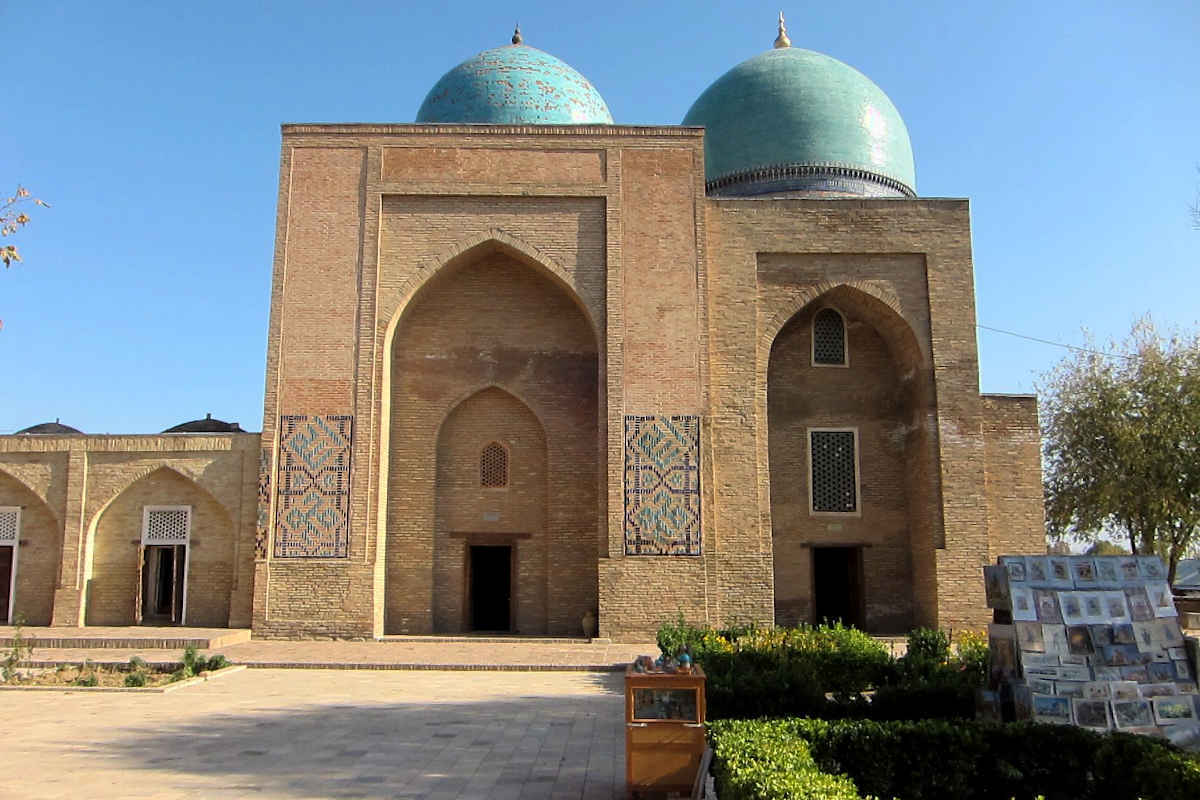Shakhrisabz - Mausoleum Shamsiddin Kulol

The mausoleum of Shamsiddin Kulol in Shakhrisabz – a spiritual and architectural jewel of the Temurid period
The mausoleum of Shamsiddin Kulol in Shakhrisabz is one of the most important religious and historical sites in Central Asia. As the final resting place of the revered Sufi master Shamsiddin Kulol, it played a central role in the spiritual development of Amir Temur and his dynasty. In addition to its spiritual significance, the mausoleum is an outstanding example of Temurid architecture and an expression of the deep reverence in which the sheikh was held.
The historical significance of Sheikh Shamsiddin Kulol
Sheikh Shamsiddin Kulol was born in the 13th century and lived until 1370. He was regarded as one of the most respected spiritual teachers of his time. His spiritual career began as a respected master potter, but his deep thirst for knowledge and philosophical inclination led him to Islamic theology. In the course of his life, he became a highly esteemed Sufi master, known for his wisdom, selflessness and spiritual purity.
He became the mentor of Amir Temur and his father, Muhammad Taraghay, and significantly influenced their religious worldview. Historical sources describe him as a man of great wisdom and charity, who stood by many people in word and deed. The Temurids paid him the highest respect and his name was mentioned with great honour.
Shamsiddin Kulol was not only a spiritual teacher, but also an advocate of the Naqshbandi Sufi tradition, which was characterised by silent zikr (remembrance of God). His most famous disciple, Bahauddin Naqshbandi, became the founder of the Sufi order named after him, which is still very important in the Islamic world today.
The construction of the mausoleum by Amir Temur
After the death of the revered sheikh in 1370, Amir Temur personally ordered the construction of a magnificent tomb. This was not only to be dedicated to his teacher, but also to serve as a burial place for his closest confidants and relatives. The tomb quickly became a place of pilgrimage where numerous followers gathered to pay their respects to the sheikh.
The original mausoleum was built in the late 14th to early 15th century as a rectangular structure measuring 12.1 x 10.6 metres. However, the original domed structure was not preserved and was later replaced by a flat roof. Nevertheless, the building remains an important testimony to early Temurid architecture.
Ulugbek and the extension of the mausoleum
Amir Temur’s grandson, the highly educated Mirzo Ulugbek, recognised the spiritual and symbolic significance of the tomb and had a magnificent domed mausoleum built over the original memorial in the 15th century.
The architecture of the mausoleum is characterised by extraordinary artistic decorations:
- Geometric and floral patterns, skilfully executed in glazed majolica.
- Calligraphic inscriptions containing verses from the Koran express respect for the honoured Sufi master.
- Masterfully carved wooden doors described as ‘gates to paradise’. These were made by the best wood carvers of the time and decorated with the finest ornamentation.
The entire structure is made of burnt bricks in a square shape (26 x 26.5 x 5 cm), which are known for their high stability and durability.
A holy site of the Temurids
In addition to Sheikh Shamsiddin Kulol, Muhammad Taraghay, the father of Amir Temur, was also buried in this mausoleum. According to reports, he was buried at the feet of his son’s spiritual teacher – a symbolic act that emphasises the Temurids’ deep spiritual connection and reverence for the sheikh.
The mausoleum was originally open on all four sides to enable a spiritual connection to the surroundings. This is a construction method that can be found in many Sufi tombs, as it was intended to reinforce the feeling of an open, boundless connection between this world and the hereafter.
Preservation and restoration of the mausoleum
Over the centuries, renovations and plastering work have been carried out several times, altering the original appearance of the walls. Under the layers of plaster, however, remains of the once magnificent mosaic decoration that once adorned the azure vault of the mausoleum can still be seen.
Inside is a square marble tomb, the surface of which was decorated with fine, ornate ornamentation. Until the 20th century, all that remained of the original mosque that was part of the complex were the foundation walls and fragments of the ornate marble tombstone.
The mausoleum today – a living monument to the Temurid era
Today, the mausoleum of Shamsiddin Kulol is an important pilgrimage site and a symbol of the deep connection between spiritual teachings and political history. Many believers visit this place to ask for blessings and honour the Sheikh’s wisdom.
The mausoleum remains one of the most outstanding examples of Temurid architecture and illustrates the extent to which the rulers of the time cultivated spiritual traditions. Its ornate decorations, spiritual significance and historical relevance make it an indispensable cultural heritage of Central Asia.
